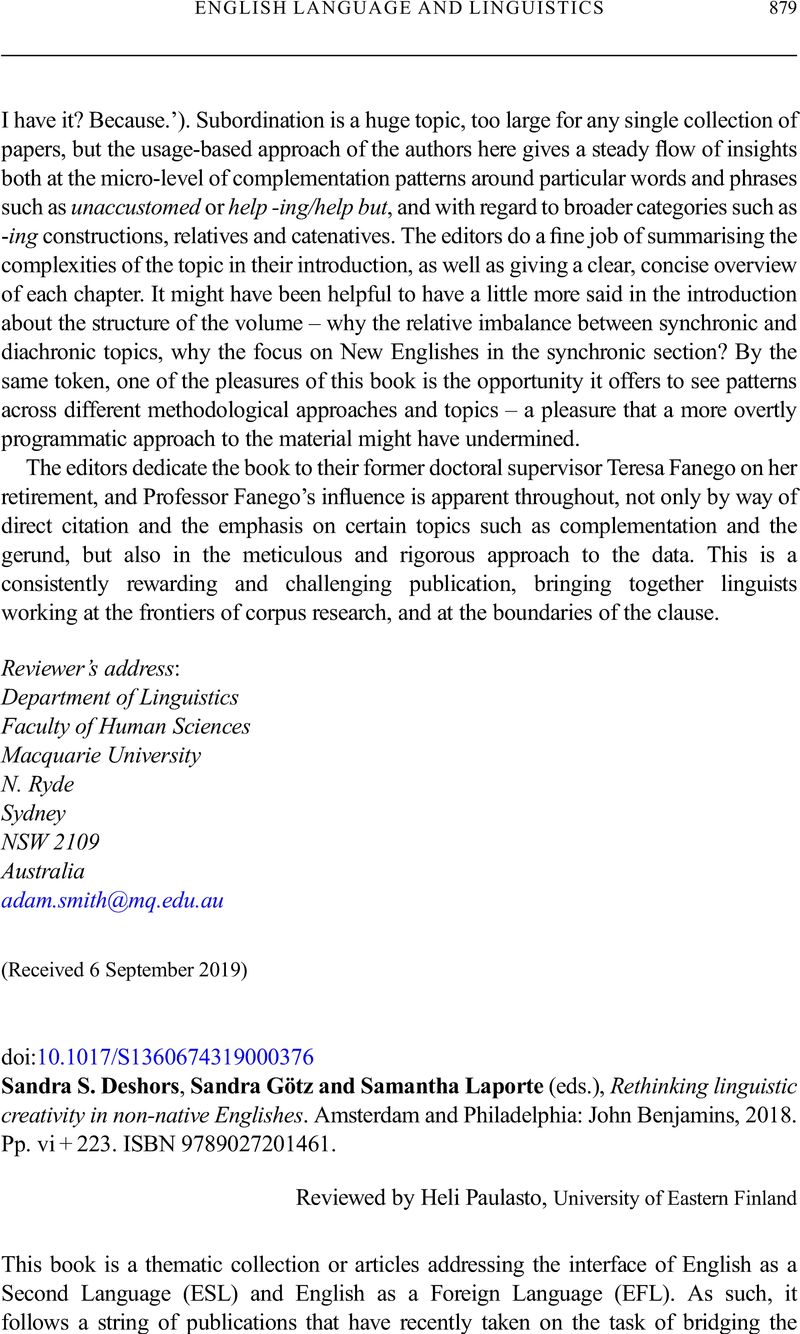No CrossRef data available.
Article contents
Sandra S. Deshors, Sandra Götz and Samantha Laporte (eds.), Rethinking linguistic creativity in non-native Englishes. Amsterdam and Philadelphia: John Benjamins, 2018. Pp. vi + 223. ISBN 9789027201461.
Review products
Sandra S. Deshors, Sandra Götz and Samantha Laporte (eds.), Rethinking linguistic creativity in non-native Englishes. Amsterdam and Philadelphia: John Benjamins, 2018. Pp. vi + 223. ISBN 9789027201461.
Published online by Cambridge University Press: 13 December 2019
Abstract
An abstract is not available for this content so a preview has been provided. Please use the Get access link above for information on how to access this content.

- Type
- Book Review
- Information
- Copyright
- Copyright © Cambridge University Press 2019
References
Alsagoff, Lubna, Sandra Lee, McKay, Hu, Guangwei & Renandya, Willy A.. 2012. Principles and practices for teaching English as an international language. London: Routledge.CrossRefGoogle Scholar
Douglas Fir Group. 2016. A transdisciplinary framework for SLA in a multilingual world. The Modern Language Journal 100 (Supplement 2016), 19–47.CrossRefGoogle Scholar
Jenkins, Jennifer. 2006. Points of view and blind spots: ELF and SLA. International Journal of Applied Linguistics 16(2), 137–62.CrossRefGoogle Scholar
Paulasto, Heli. Forthcoming. Sanastollista luovuutta ja kieltenvälistä vaikutusta yhteisötaideryhmän lingua franca-englannissa [Lexical creativity and cross-linguistic influence in the lingua franca English of a community art group]. In Kolehmainen, Leena, Riionheimo, Helka & Uusitupa, Milla (eds.), Tviittivirrasta veroluetteloihin. Näkökulmia Itä-Suomen monikielisyyteen. Helsinki: SKS.Google Scholar
Schneider, Edgar W. 2004. How to trace structural nativization: Particle verbs in world Englishes. World Englishes 23(2), 281–98.CrossRefGoogle Scholar
Schneider, Edgar W. 2012. Exploring the interface between World Englishes and Second Language Acquisition – and implications for English as a Lingua Franca. Journal of English as a Lingua Franca 1(1), 57–91.CrossRefGoogle Scholar
Seidlhofer, Barbara & Widdowson, Henry. 2009. Conformity and creativity in ELF and learner English. In Albl-Mikasa, Michaela, Braun, Sabine & Kalina, Sylvia (eds.), Dimensionen der Zweisprachenforschung – Dimensions of second language research: Festschrift für Kurt Kohn, 93–107. Tübingen: Narr.Google Scholar
Sifakis, Nicos & Bayyurt, Yasemin. 2018. ELF-aware teaching, learning and teacher development. In Jenkins, Jennifer, Baker, Will & Dewey, Martin (eds.), The Routledge handbook of English as a lingua franca, 456–67. London: Routledge.Google Scholar
Sridhar, Kamal K. & Sridhar, S. N.. 1986. Bridging the paradigm gap: Second language acquisition research and indigenized varieties of English. World Englishes 5(1), 3–14.CrossRefGoogle Scholar
Van Rooy, Bertus. 2011. A principled distinction between error and conventionalized innovation in African Englishes. In Mukherjee, Joybrato & Hundt, Marianne (eds.), Exploring second-language varieties of English and learner Englishes: Bridging the paradigm gap, 189–207. Amsterdam: John Benjamins.CrossRefGoogle Scholar
Williams, Jennifer. 1987. Non-native varieties of English: A special case of language acquisition. English World-Wide 8(2), 161–99.CrossRefGoogle Scholar





